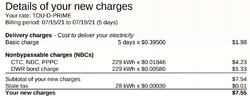My understanding is that SCE gives us two different accounting for solar, one billed on a monthly basis and one account balance that is settled on an annual basis. This is in no way refuting anything posted previously, just my own observation of how SCE is doing things and the way I'm explaining it to myself... dunno if it'll help anyone, but that's what posting thoughts are for, right?
Each day, SCE looks at the grid energy you use and the grid energy you generated. It looks at your net energy usage for each day during the month to see if you owe the 'minimum' daily, as a bill. The account balance is determined by the grid energy used, at the various peak/non-peak rates, and the energy you generated at the various peak/non-peak rates. This is a pure $+/-, so you can pull during off-peak, but generate during peak, and end up with a credit on your account balance.
Let's pretend a month is only 2 days, with $0.27 off-peak, $0.42 peak, $0.07 baseline (I think that's my SCE TOU-4-9)... if you pull from the grid on Monday 10kW off-peak and 2kW peak, they will charge you (10*$0.27) + (2 * $.042) - (12*$0.07). ($2.70)
If on Tuesday, you pull 10kW off-peak but generate 12kW during peak, they will charge you: 10 * $0.27 - 10 * $.07 ($2.00) for the off-peak and (12 * -$0.42) - (12 * -$.07) (-$4.20) for a total of -$2.20, plus that one day minimum daily of $0.35.
Combined, your Monday ($2.70) and Tuesday (-$2.20) would add $0.50 to your account balance plus one day of $0.35 minimum for a final $0.35 monthly bill. You pulled 20kW off-peak and -10kW peak for a net use of 10 kW that month.
If instead of just 12 generated during peak on Tuesday, you had generated 30 peak... then it would've been (30 * -$0.42) - (30 * -$0.07) or (-$10.50) while using 10kW offpeak ($2.00) your combined Monday ($2.70) and Tuesday (-$8.50) would give you a -$5.80 account balance, plus one day of $0.35 minimum for a final $0.35 bill... this carries over to next month and so forth, for the year. You pulled 20kW off-peak and -28kW peak for a net use of -8kW that month.
Now, if all 12 months were at the -$5.80 account balance, with a net use of -8kW, you would end up with a -$69.60 account balance on month 12, and a net producer of 96kW. Throughout the year, you had paid a $0.35/month bill ($4.20) From what I can tell, at that point, at the end of the annual cycle, they clear your -$69.60 account balance to $0 (it was a use-it-or-lose-it proposition) but give you the net producer rate of the month for the 96kW (which averages $0.03) so you would get a check (or bill credit) of $2.88 to start the next 12 month cycle. So, for the year, you paid $4.20 (monthly bill) and got $2.88 for the energy generated.
Unfortunately, there's also some delivery and generation charges that they split out to complicate matters on the monthly bill, but that should be the gist of it.
So, each month, I get billed around $12 for the minimum daily, but show some growingly big credit if it was sunny. That credit is used during the overcast/rainy days and it won't matter much until the end of my annual cycle. To add to the complication for California, we get a $25 bill credit in March and a $25 bill credit in October for some environmental thing... so for some months, I suddenly had a credit on the monthly bill which paid for around 2 months, in addition to the account balance credit.
Now, to do the math based on TOU-Prime of $0.17 off-peak, $0.45 peak, no baseline, $0.40 daily base charge, using the Monday 10kW offpeak, 2kW peak, Tuesday 10kW offpeak, -30kW peak, it would be something like: Monday 10*$0.17 + 2*$0.45 = $2.60 + $0.40 daily. Tuesday (10*$0.17) + (30 * -$0.45) = -$11.80 + $0.40 daily. Combined, account balance of -$9.20, net use of -8kW still, but a $0.80 bill monthly, for a final 12 month of -$110.40 account balance, net producer of 96kW. Throughout the year, you paid $0.80/month ($9.60) and got $2.88 for the energy generated.
I'm sure someone can create a spreadsheet to calculate the ROI, tipping point, and what not between the different energy usage patterns and TOU-4-9 vs TOU-PRIME... alas, I'm not that person

Edit: forgot to deduct the 10kW offpeak on Tuesday, that changed the numbers a little bit.




